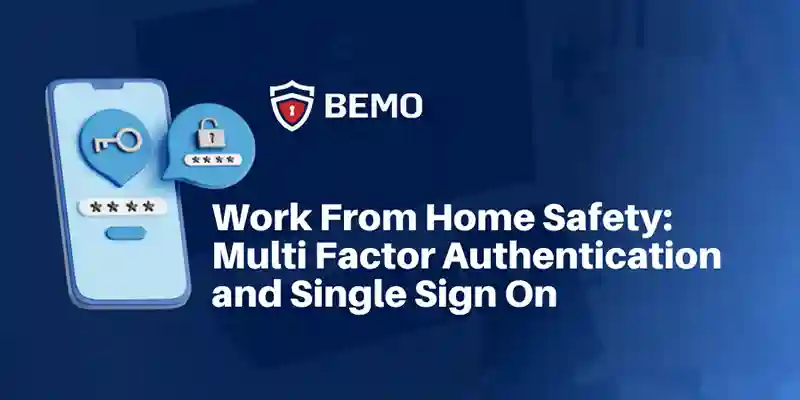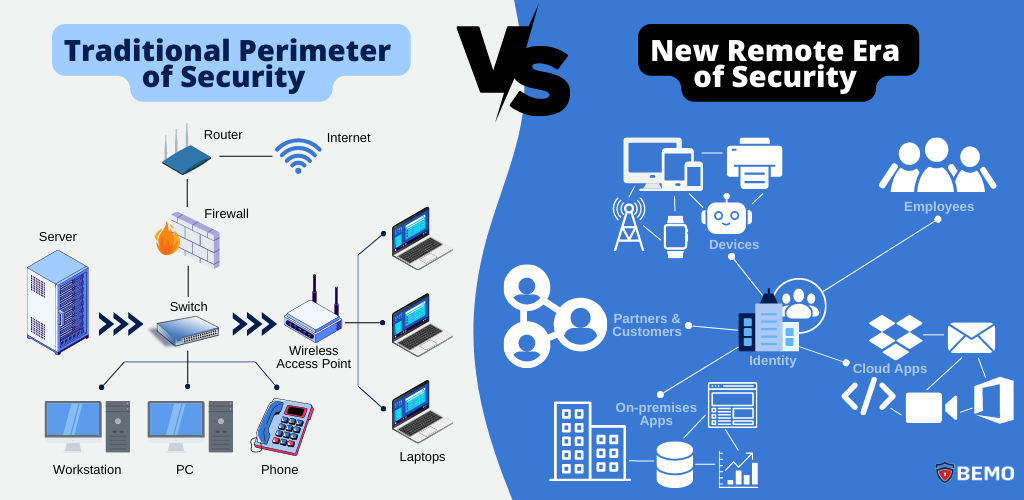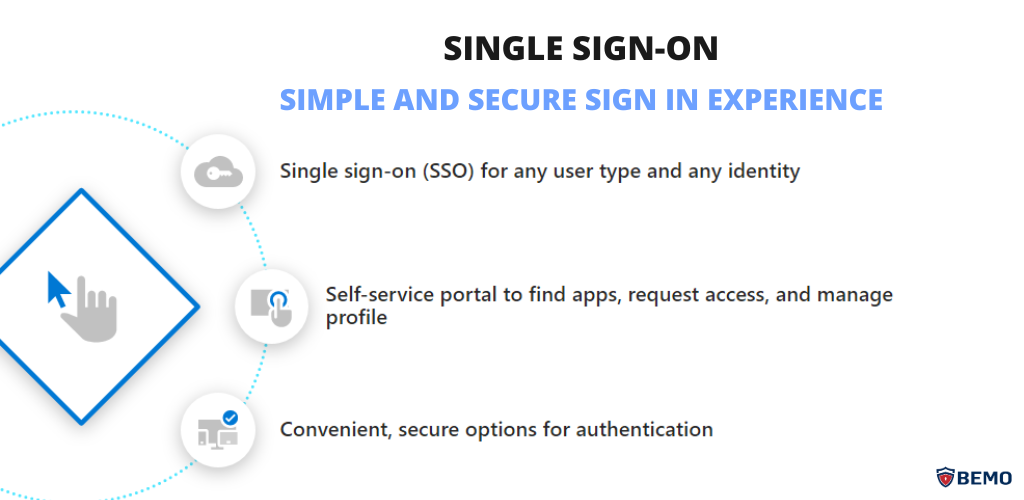4 min read
Work From Home Safety: Multi Factor Authentication and Single Sign On
![]() Laura Arce Fonseca
on Mar 25, 2025
Laura Arce Fonseca
on Mar 25, 2025

As an SMB owner, you may be concerned about the potential impact of Identity Protection on your employees' productivity. After all, implementing security measures often means more hoops to jump through and extra steps to take. What if we told you, it could actually enhance productivity, rather than hinder it?
By implementing Identity Protection measures such as multi-factor authentication (MFA) and single sign-on (SSO), you're adding an extra layer of protection to your company's sensitive information without overcomplicating any process. But what are they and how they they work?
In this article, we'll explore how you can leverage the power of SSO and MFA to enhance your business security posture without sacrificing productivity. We'll delve into the benefits of these features and how they can be streamlined for maximum efficiency.
Get ready to level up your IT security game!
Table of Contents:
Why Remote Work Security Matters for SMBs
The challenges of distributed work can be a real bump in the road to digital success. Without a physical office network, employees accessing company data from personal devices pose a significant security risk. Traditional security measures, like firewalls and secure networks, are less effective when workers are spread across various locations and using non-secure devices.
Staying productive and connected with colleagues, customers, and partners is one of the main challenges. This is difficult to do without a physical network perimeter for security.

Traditional office settings had a physical network perimeter. This created a sense of security, as it acted as a barrier to external threats. It protected the internal network from outside dangers. However, with distributed work, employees may be working from various locations and devices, making it challenging to maintain the same level of security.
Employees may use their personal laptops, smartphones, or other devices to access work-related information, but these devices may not have the same level of security measures as company-owned devices. This can potentially lead to data breaches or other security incidents, posing a significant risk to the organization's sensitive information. Let’s go over some tools you can use to protect your data.
What is Multi Factor Authentication?
To prevent cyber attacks or exposure of sensitive data such as passwords you can configure Azure AD’s advanced multi factor authentication (MFA) and conditional access policies to ensure that only the right people have the right access to the right data.
MFA is, as the name implies, refers to using multiple methods of identity verification to allow access to users. Typically, in addition to a password, users are required to provide an extra authenticator. This is stronger than using 1 method alone and will instantly boost your security and massively reduce risk of breach. It’s the #1 security control you must have enabled.
MFA is one of the easiest and quickest ways to improve your security posture, because passwords can be cracked relatively easily. Think about it, do you know anyone who uses the same password for all sites they log in? Or is this you? If a hacker gets it, they could have full access to your information.
So if you are currently relying simply on passwords alone, go and turn on MFA now! In general, MFA comes down to a combination of two or more of the following methods:
.png?width=1024&height=500&name=MFA%20(3).png)
With these features, you can control who, when, and where apps can be accessed. It makes user authentication safer without impacting the user experience.
How Conditional Access Enhances MFA Security
To create a more customized security experience based on your needs and end-user usability, you can enable Conditional Access policies to define events or applications that require MFA. This feature allows regular sign-in when the user is on the corporate network or a registered device, but prompts for additional verification factors when the user is remote or on a personal device.
Conditional Access policies can also be set up to require MFA when risky sign-on situations are encountered, such as different locations, devices, or times than usual. This ensures that your business is protected against potential threats.
For example, if you or your employees are working from home as usual, you may have no MFA at all. But if all of a sudden, an attempt to sign into their account is detected from a different city or way past work hours, Conditional Access policies would be triggered requiring that user to use MFA in order to gain access.
Moreover, with Conditional Access policies, you can also limit the number of times users are prompted for MFA by setting up access requirements only for specific apps or situations. This prevents users from being prompted for MFA every time they log in, which can cause MFA fatigue and frustration (we’ll make a future post on this later, so make sure to subscribe for when that one drops!)
Talk about maximizing security AND creating a simple and easy experience for your users!
What is Single Sign-on?
Another great tool to elevate your security game is Single Sign-on (SSO).
Single Sign-On is a system that allows users to authenticate themselves just once and then be granted access to multiple applications or systems without having to log in again.
This is how it works: when the user signs in, SSO securely stores their authentication information in a central location. Later on, when the user wants to access a different application or system, the SSO system automatically sends the stored authentication information, eliminating the need for the user to re-enter their login credentials.
The Benefits of Single Sign-On (SSO) for SMBs
Single Sign-On (SSO) simplifies the authentication process by allowing users to log in once and gain access to multiple applications without needing to remember numerous credentials. This not only reduces password fatigue but also strengthens your security by limiting risky workarounds employees might use to avoid multiple logins.
By implementing SSO, you improve productivity while also reducing the number of help desk calls related to password issues. Studies show that 23% of security breaches are caused by employee mistakes—many of which are the result of weak password practices.
A fast, easy sign-in experience such as SSO, lowers frustrations, risky behavior, security events, and improves productivity.

If you're interested in learning more about how BEMO can enable and customize these features to your SMB's needs, be sure to check out our Office Hours Video: Are Your Employees Your Weak Spot? A Workshop to Secure Your Company's Data.
How to Set Up MFA and SSO with Microsoft
Microsoft offers MFA and SSO through Azure AD and Microsoft 365 Business Premium. For MFA, use features like Windows Hello for Business, which allows biometric authentication (fingerprint or face scan) for secure access.
For SSO, Microsoft 365 Business Premium lets you access SaaS apps like Salesforce and Adobe with a single login. In addition, Business Premium includes essential tools like Self-Service Password Reset (SSPR), reducing IT costs and improving user experience.
Maximize Your Security with Microsoft 365 Business Premium
By upgrading to Microsoft 365 Business Premium, you gain access to a suite of tools that enhance your security posture. Along with MFA and SSO, it includes features like advanced threat protection and data loss prevention, ensuring that your data is secure from breaches and unauthorized access.
Need Help Setting Up MFA and SSO for Your SMB?
If you're ready to boost your business security and enhance remote work security, consider scheduling a consultation with one of our experts. Learn how MFA and SSO can streamline your processes and protect your company.
Top 10 Posts
-
Google Workspace to Office 365 Migration: A Step-by-Step Guide
-
How to Migrate from GoDaddy to Office 365
-
Office 365 MFA Setup: Step-by-Step Instructions
-
Migrate From Gmail to Office 365: 2024 Guide
-
What are the 4 types of Microsoft Active Directory?
-
How to remove Office 365 from GoDaddy (tips and tricks)
-
CMMC Meaning : A Comprehensive Guide for Startups
-
How to Set Up Office Message Encryption (OME)
-
What is Microsoft Purview ? Your A to Z Guide to Getting Secure Fast
-
What is The CIA Triad?


Leave us a comment!